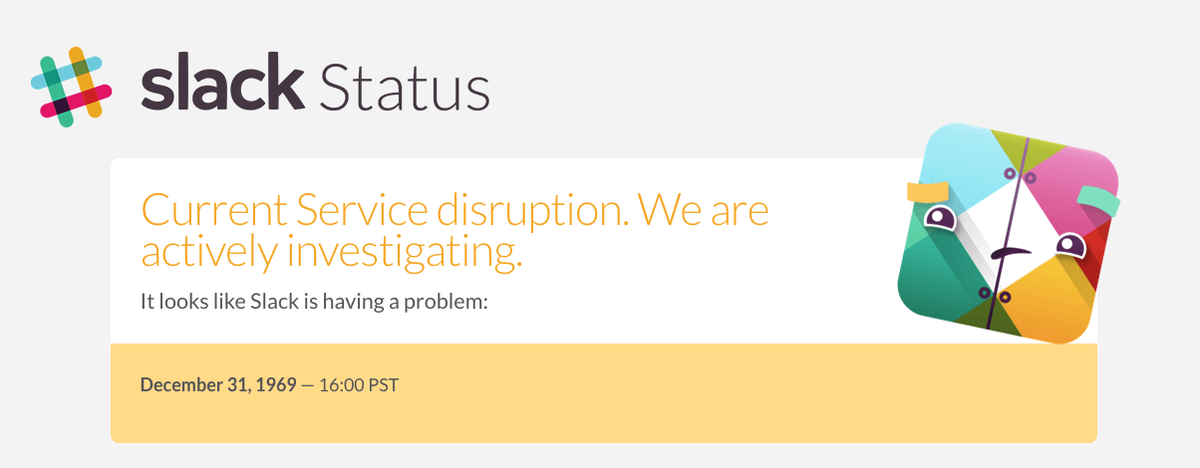Contents
Tuesday, November 23, 2015 started out like any other day at work for James Crenson. Coffee, check email, prep documents for weekly meeting, solicit input from co-workers on slack. Um, Slack?
At 8:50 a.m. EST, popular workplace messaging service Slack suffered a massive outage, leaving over a million users around the world unable to send or receive messages and files for almost three hours in the middle of the workday. Angry users took to twitter and other social messaging sites to complain about the inconvenience. The situation had the potential to explode, but Slack was ready.
The team messaging tool had a solid plan in place for mass outages. A well-coordinated group effort handled support issues including a comprehensive social media blitz to contain the negative customer experience (CX). Over the few hours that the service was down, the official @SlackHQ account tweeted over 2,300 times with humorous, thoughtful, and most importantly, personalized – responses to customers complaining about the service outage. Not only did the all-out response wow users, but @SlackHQ gained over 3,300 followers – 7x more than average – on a day that could have gone down as the worst in company history.
Slack was able to quickly contain the damage, took complete responsibility, kept its customers well informed and handled a stressful situation with humor and efficiency. Throughout this process, Slack deepened the trust of existing customers by demonstrating that the company was prepared in times of crisis. Its expert handling of a negative situation enhanced its relationships with existing customers, boosted the brand’s reputation and even served as a springboard for an expanded customer base.
This is an exceptional demonstration of the value of the phenomena known as the “service recovery paradox.”
Service Recovery Paradox – Turning Failure Into Opportunity
The service recovery paradox (SRP) refers to the seemingly absurd phenomena when a customer thinks more highly of a company after a service failure compared to how he or she would regard the company if non-faulty service had been provided. The paradox occurs specifically when the company corrects the service issue in an efficient manner, demonstrating respect and consideration for the customer and his or her needs.
Handling a negative situation well and restoring customers’ faith in your business can actually improve overall satisfaction with your product or service. Similar to any relationship, customer-brand relationships are best evaluated in times of crisis, specifically when the customer needs the brand most. When service is disrupted, the customer takes the opportunity to evaluate his relationship with the brand, such as how much effort will the brand expend to ensure the service is recovered efficiently. Swift crisis recovery shows a trustworthy brand that is well prepared and organized to handle crisis. If the brand is there for him, by providing a quality response and high level of effort, the customer judges the brand favorably and their relationship is deepened. The White House Office of Consumer Affairs reports that 96% of customers who have complained about a product/service will do business with the brand again (and even refer others to the brand) if they feel the brand acted quickly to resolve the problem.
The Opportunity: 2-Stage Proactive Strategy
Companies that want to tap into the service recovery paradox should ensure they have a proactive plan in place for when something goes wrong. A good strategy is divided into two stages:
Before the crisis strikes
Prepare for a smooth recovery process.
Identify potential service pitfalls. Consider every possible crisis scenario, and investigate how each scenario would impact your customers. Determine the most important pain points to focus on while working towards a resolution. Analyze the costs, scope, and damages of the potential crisis; companies often neglect to take the proactive steps necessary to retain valuable existing customers, even though loyal customers are worth up to 10 times as much as their first purchase, on average.
In addition, an inefficient or sloppy recovery process can generate negative word-of-mouth, which can significantly damage a brand’s reputation. While there are certainly monetary outlays required for crisis preparation, the benefits of being well-prepared to effectively handle a service outage or other negative situation will surely outweigh any costs incurred.
Remember that in times of crisis, chaos and confusion is your enemy. Set clear priorities and guidelines, and empower executives to make customer-centric decisions based on prioritizing customers’ needs during a crisis.
Empower the front lines.
Customer service agents are key employees. This is most apparent in times of crisis. When high volumes of customers are calling for support, the first line must be fully empowered to drive customer retention. Make sure agents are fully aware and onboard with all company policies, and are armed with the right responses when contacted by customers. Underline the importance and priority of service recovery, empowering agents to give monetary or other forms of compensation to unsatisfied customers. Ensure agents have appropriate training to succeed in their roles and are provided with appropriate incentives to reach their goals of meeting strict KPIs. Provide your front line with enabling technologies , such as visual support or hybrid and autonomous AI solutions, so they have innovative and effective tools to wow customers, especially in times of crisis.
After the crisis strikes
Take ownership and communicate effectively before the crisis escalates.
According to consulting firm TARP (Technical Assistance Research Firm) Worldwide, 96% of unhappy customers do not complain, creating an onus on the brand to identify sore spots and address them proactively. When a crisis occurs, brands must be proactive with messaging. If your service is experiencing an outage, inform customers before they even notice. This creates a personalized experience and decreases inbound calls to your call center. Give specific and frequent updates to keep customers in the loop and explain how you are working diligently to resolve their problem. Be totally transparent, do not blame others or use high-level technical language. Clear communication is vital for maintaining customer trust.
Close the customer feedback loop.
Once the crisis has been averted or resolved, don’t leave customers in the dark. Clearly communicate the reason for the outage and any preventative steps being taken. If a customer’s complaint has led to corrective measures, inform the customer about the improvements. Closing the loop makes customers feel as if they are part of a team and further drives loyalty.
Summary
Service organizations cannot always avoid disappointing customers. Crises occur, no matter the extent of the company’s contingency plans. As demonstrated with the Slack outage, customer satisfaction depends on the brand’s ability to recover with efficiency and grace, and invoke the service recovery paradox. Just as we admire and sympathize with the athlete who falls mid-race but jumps back up and crosses the finish line, we look for similar qualities in our brands. Enduring the difficult times is what builds loyalty and gives the relationship substance and longevity. With the right plan in place, including empowered employees, straightforward communication and immediate responses, even the worst service failures can be transformed into a positive CX.







